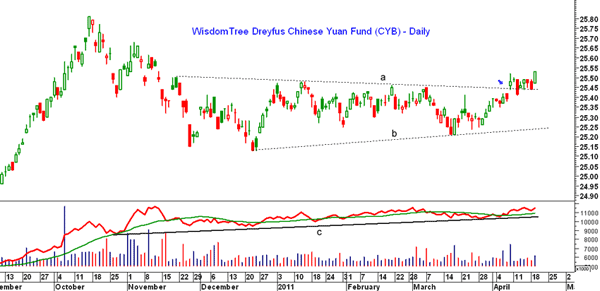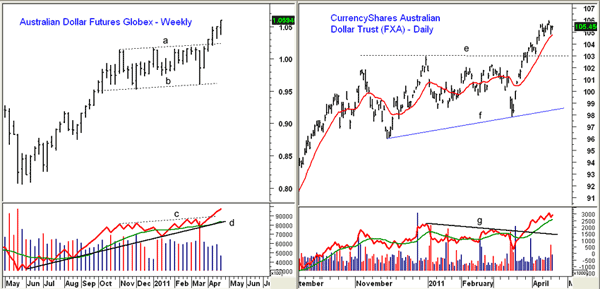Traders and investors looking for exposure to non-dollar-denominated assets may choose from two of the more liquid currency ETFs set to benefit from growth of the Chinese yuan.
Monday’s plunge in global equity prices briefly boosted the dollar, giving some hope that it was finally bottoming. The optimism didn’t last long, however, as the dollar gave up most of its gains on Tuesday.
The negative technical outlook for the dollar is in agreement with the bearish fundamentals, and S&P’s recent downgrade of its US debt outlook is likely to add further downward pressure over the next few months.
The downgrade of US debt may have accelerated plans by the Chinese government to make the yuan more of a global currency. A Tuesday Wall Street Journal interview with a Hong Kong monetary official hinted that discussions were underway to make it easier to bring yuan funds raised overseas back into China.
This would open up the Hong Kong debt markets to many companies and they would be able to invest in China without converting to dollars. Under current guidelines, large transfers of all currencies coming into China must be approved by the government.
Recent data suggests that the yuan is already becoming more global, as 7% of the foreign trade in the first quarter was in yuan, which was a sharp increase from just 0.5% last year. Of course, currency traders go where the yield is highest, and Chinese tightening over the past six months also makes the yuan more attractive. Nevertheless, do not expect the yuan’s value to be determined by the free markets for some time.
Also attractive from both a growth and yield standpoint is the Australian dollar, as its major uptrend is still strong despite the impressive gains of the past two years.
Chart Analysis: The most liquid way for US investors to participate in a higher yuan is through the WisdomTree Dreyfus Chinese Yuan Fund (CYB), which seeks to “achieve total returns reflective of both money market rates in China available to foreign investors and changes in value of the Chinese yuan relative to the US dollar.”
- Prior to today’s headlines, I had noticed that CYB had broken out of its trading range (lines a and b) on high volume several weeks ago. CYB then consolidated its gains for a week before turning higher on Tuesday
- There is next resistance on the daily chart at $25.68-$25.81 with highs from 2009 at $26.50 when trading was very thin
- Initial support is now at $25.35-$25.45 with more important support at $25.10-$25.20
- The daily OBV pattern is positive, as it has held good support, line c, and turned up on Tuesday
NEXT: Strong Yuan to Boost Australian Dollar: How to Play it
|pagebreak|The Australian economy came out of the financial crisis very strong and the Australian dollar has had a dramatic rally from the March 2009 lows at .6280 to its current level near 1.0600. A large percentage of the growth in the Australian economy is because of increased trade with China.
- The weekly chart of the Australian dollar futures shows the completion of the five-month trading range in early April
- Upside targets from this formation are in the 1.08 area. The upper trend line on the weekly chart is now in the 1.14-1.16 area
- The weekly on-balance volume (OBV) has confirmed the price action by moving through resistance (line c), and the OBV is in a strong uptrend, line d
- The aussie has initial support now in the 1.03-1.04 area with much stronger support at 1.02 (line a)
The CurrencyShares Australian Dollar Trust (FXA) tracks the exchange rate of the Australian dollar and currently yields 3.1%. The daily chart of FXA also shows the completion of a trading range (lines e and f) as resistance at $103 was overcome.
- The width of the trading range has targets now in the $110 area
- Short term, FXA is quite extended after rising from a low of $97.82, which was made when stock prices dropped sharply on March 16
- The daily OBV has supported the rally in FXA as it has overcome the resistance at line g, and is above its rising weighted moving average (WMA). The weekly OBV (not shown) is also positive
- Initial support is now at $104.50 with stronger support at $102.30-$103.40. A break back below the $100 level would be a negative sign
What It Means: Exposure to assets that are not denominated in US dollars is one way to help diversify your portfolio. Of course, this can also be done using ETFs or mutual funds that do not hedge their exposure to swings in the currency markets. Remember that currency ETFs are often quite volatile and should only make up a small part of even more aggressive portfolios.
How to Profit: After such a protracted decline, it is tempting to try to pick a bottom in the dollar index, but the trends in the currency markets are especially strong. The weekly pattern of lower highs and lower lows in the dollar index will take some time to reverse, so those trying to pick a bottom in the dollar should be very careful.
Before today’s headlines, finding a good risk/reward entry point in either CYB or FXA would have been much easier. Both are likely to move significantly higher, but clearly, a pullback is likely in the next week or so.
As is always the case with ETFs, limit orders and stops must be used because quite often the spread between the bid and ask can be very wide.
For CYB, I would go 50% long at $25.56 and 50% long at $25.44 with a stop at $24.88 (risk of approx. 2.4%).
FXA is also likely to open strong as the Australian dollar futures are sharply higher in European trading. Therefore, FXA should open close to $107. Go 50% long at $105.54 and 50% at $104.22 with a stop at $99.66 (risk of approx. 5%).



















